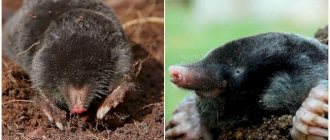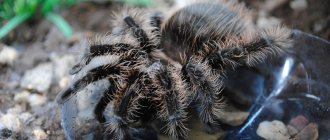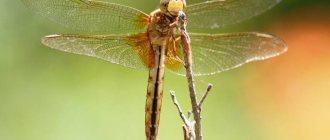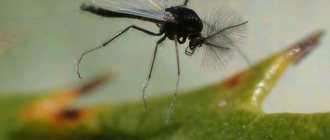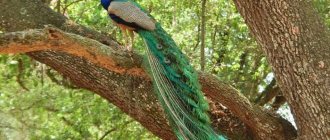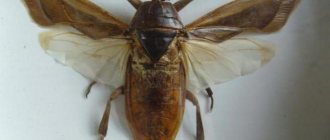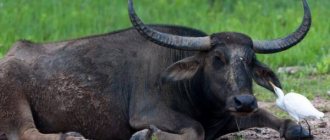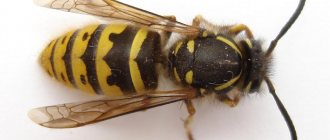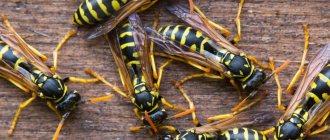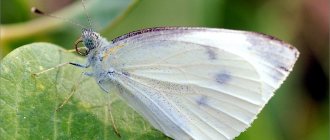Description of Sympetrum vulgatum
Insect classification:
- Order – dragonflies (Odonata).
- Family – true dragonflies (Libellulidae).
- Genus – compressed bellies (Sympetrum).
- Species: common dragonfly (Sympetrum vulgatum).
Body structure and coloring
Dragonflies from the genus Sympetrum or compressed bellies are typical representatives of the fauna of Russia. Their body length is 38-40 mm, of which the abdomen accounts for up to 28 mm. The head is large, well defined, mobile. In the imago it is wider than the thorax and is movably connected to the prothorax. The eyes are large, complex, and consist of 20-30 thousand individual facets. The upper part of the organ is responsible for recognizing the outline of objects, and the lower part distinguishes colors. The antennae are presented in the form of short thin bristles. There are three simple ocelli located on the crown. A black stripe runs across the brown head, between the crown and forehead. The mouthparts are of a gnawing type, with strong mandibles equipped with sharp teeth.
The insect's chest contains limbs and two pairs of wings. The posterior part of the prothorax has a vertical projection. A fringe of long hairs grows on it. Black stripes run along the chest seams. The back of the dragonfly is pushed back obliquely, so the wings are behind the limbs. Males of the common compressed belly have a red chest with three black stripes, females are yellow-brown, three stripes are also present.
Wings
Dragonflies are equipped with two pairs of wings. In heteroptera, the front pair exceeds the parameters of the rear pair. The wing plate is formed by two chitinous layers and reinforced by veins. Their length is approximately equal to the size of the body. The hind wings are widened at the base. The wingspan of Sympetrum vulgatum is 60 mm, the length of the hind wing is 24-29 mm, the length of the front wing is 33-37 mm. The venation is very dense, large veins contain hemolymph, small veins have no gaps. One of the significant areas is the pterostigma, a thickening in the front of the wings. Outwardly, it looks like a dark spot; during flight, it weighs down the top of the wing, allowing it to increase the amplitude of the flapping.
Limbs
The legs of the common dragonfly are black, with a yellow stripe running along the outside. Three pairs of limbs are designed to hold the insect's body and catch prey. They are not used for walking or running. The legs consist of 5 main parts:
- basin;
- trochanter;
- hip;
- shin;
- paw.
On the inside of the leg and thigh there are several rows of spiny bristles. The coxa is the thickest and shortest part of the limb. There are two sharp forked claws on the foot. Long limbs and spines allow them to form a “catching basket” to catch prey in the air.
Abdomen
The abdomen of the common dragonfly is flattened and wide. It consists of 10 full and one rudimentary segment. Each part is formed by an upper and lower chitinous shield. Thanks to the movable joint, insects can freely bend their abdomen. The structure of the organ of males and females is different. Males have special appendages on the last segment to hold the partner during mating. Their secondary copulatory organ is located in the lower part of the second segment. The female's genital opening is between the eighth and ninth segments. Females have an ovipositor. Males have a red abdomen with a black side stripe, while females have a brown abdomen with a black stripe.
Larvae
Dragonfly larvae are called nymphs or naiads. In appearance and structure they are strikingly different from the imago. Nymphs of the common dragonfly have a massive body 17-19 mm long. Breathing is carried out through internal organs - rectal gills. The larvae take water into the rectum, where gas exchange occurs. The body color is dark gray, greenish or red-brown. The nymphs are covered with a motley pattern.
Forehead with a T-shaped black spot; runs along the border of the forehead and clypeus
^ Green rocker (Ae. Viridis) ^ Blue rocker (Ae. Cyanea) ^ Large rocker (Ae. Grandis) ^ Genus Watcher –Anax Leach. ^ Emperor Watcher (Anax Imperator) ^ Family True dragonflies - Libellulidae. ^ Genus Libellula (libellula) Flat dragonfly (Libellula depressa) ^ Genus Orthetrum (orthetrum) Newm. ^ Lattice dragonfly
(O. cancellatum). Genus Sympetrum (sympetrum) Newm. ^ Yellowish dragonfly (S. Flaveolum) ^ Common dragonfly (S. Vulgatum).
- Bandaged dragonfly (S. pedemontanum)
- Black dragonfly (S. Danae sulzer)
- Blood red dragonfly (S. Sanguineur).
Genus Reucorrhinia (Leucorrhinia) Britt.
- White-fronted dragonfly (L. albifrons);
- Red dragonfly (L. rubicunda);
- Swamp dragonfly (L. pectoralis).
Grandmother family - Corduliidae. ^ Genus Grandmother – Cordulia Leach. Bronze headstock (C. Aenea).
Genus Somatochlora (somatochlora) Selys
Form and structure
The female dragonfly lays eggs in water, attaching them to a variety of plants, silt or moss. After 14-35 days, arachnid pre-larvae hatch from them (less than 1 mm), immediately molt, then move to the next stage and continue their development in the water element. Oddly enough, the dragonfly larva is called a nymph, or a naiad. Whoever came up with this clearly had a good sense of humor.
The respiratory system and oral apparatus of a nymph are radically different from that of an adult. This is due to the aquatic lifestyle. The naiad breathes through gills, a kind of organ located in the hindgut. Oxygen enters through the anus along with water. The larva sucks it in like a powerful vacuum cleaner.
The “spent fuel” is thrown out with force, like a jet stream, and pushes the naiad forward. This is how she moves.
Appearance of a naiad
The dragonfly larva looks like a caricature of a cockroach drawn by different artists. Depending on the species and group to which the adult belongs, the body of the nymph can have a different shape. For some it is thick and short, for others it is more elongated and slender. In its front part there are three pairs of legs. In relation to the body, they are longer than those of an adult dragonfly. An interesting feature is that in the early stages of its development, a naiad can regrow a severed leg.
Body color varies in olive-brown tones.
On the sedentary head of the nymph, huge compound eyes stand out on the sides, and a well-developed jaw, which is equipped with a special organ called a “mask”. This is an overgrown lower lip that performs a grasping function during hunting. The mask has:
- two chins;
- distal blade;
- labial palps-lobes.
It can extend forward and fold back.
As the naiad develops, it becomes more and more like an adult, but before becoming a dragonfly, it needs to molt 7 to 11 times or more.
These insects undergo incomplete transformation, that is, they bypass the pupal stage, and the entire cycle takes from 1 to 3 years. The last moult occurs on land - the larva attaches to the plant and sheds its skin. A winged beauty is born.
The entire cycle of transformation of a naiad into a dragonfly takes from 1 to 3 years.
Born predator
Without exception, all types of dragonflies (both nymphs and adults) feed on insects, often blood-sucking (horseflies, mosquitoes, midges). The dragonfly's body shape is ideal for hunting on the fly. These insects are “lean”, with a pronounced chest and elongated abdomen.
The head of a dragonfly is very mobile. There are two complex compound eyes on it, allowing the insect to see everything that happens around and behind, and between these two there are ordinary ones, which serve for orientation in space.
The organs of vision are designed in such a way that a dragonfly sees best against the sky. Therefore, she attacks the victim from below. The insect has a powerful mouth (“gnawing,” as scientists say), short antennae and stiff legs covered with hairs that help capture prey. Each representative of the order has two pairs of wings, which are equally well developed.
This means that it is a bimotor insect. Dragonflies can fly at speeds of over 55 km/h.
Distribution and migrations
It is found on all continents (a rare species in Europe), except Antarctica. Numerous observations and captures of individuals have shown that the species is distributed over a very wide region, between the 40th parallel or within the region with an isotherm of 20 °C (that is, where the average annual temperature is above twenty degrees Celsius), and in North America up to 50th parallel. In Europe there are only isolated occasional records of the species, mainly in the Mediterranean region. All occurrences of the red tramp in Great Britain and France are associated with commerce and transportation along with fruit and other similar goods. An explanation for the rarity of the species in Europe is the barrier effect of the Sahara, which generates unfavorable winds such as the Sirocco, whose dryness makes the passage of dragonflies almost impossible.
Their flights in the subtropics and tropics coincide with the intertropical convergence zone. Evidence of their preference for moist winds is that these dragonflies migrate to Tamil Nadu in Southeast India only after the second monsoon, which brings rain to the region. However, in the rest of India, the red-headed stray appears with the first rainy monsoon. Observations and data obtained using stable isotopes indicate that they migrate from India and onwards through ocean islands to Africa via the Arabian Sea. Dragonfly migrations in India begin in September, in the Maldives they first appear in October, in the Seychelles in November (4° S, 2700 km from India) and on Aldabra Atoll (9° S, 3800 km from India) in December, after which they fly to East Africa. Taking into account return migration, the total route of migrants (possibly up to 4 generations) is 14,000–18,000 km (for an individual up to 6,000 km).
The highest flying species of dragonfly, recorded in the Himalayas at an altitude of 6200 m. It is also the first species of dragonfly to colonize Bikini Atoll after nuclear explosions were carried out on it (from 1946 to 1958). It is also the only species of dragonfly found on Easter Island. Presumably, in cold parts of its range, for example, in southern Canada and South Australia, this species does not overwinter, but there is further annual recruitment by migrating generations from other regions.
According to recent research conducted by biologists from Rutgers University-Newark, this species of dragonfly is considered the longest known traveler in the world. Genetic data taken from dragonflies around the globe suggests that these small insects travel long distances to mate and thus create a global gene pool. Another study concluded that the red tramp as a species represents an almost global single panmictic population in which an equilibrium distribution of frequencies of genotypic classes of different individuals is achieved.
The species is known for its penchant for long-distance flights and migrations, which is reflected in the morphology of the species - they have one of the largest relative area and length of wings among heteroptera dragonflies. In addition, this species is characterized by the ability to develop in small temporary reservoirs. With the help of these adaptations, every year during the warm season, adults migrate from the main part of their range to much more northern latitudes, where they reproduce, but are not able to survive the winter (and freeze out, for example, in Japan). Some representatives of this species are also found in more northern regions, for example, in Transbaikalia and Kamchatka.
Benefits and harms
The benefit is that adult dragonflies eat annoying and harmful insects (mosquitoes, flies and others), their larvae destroy mosquito larvae. However, dragonflies spread a dangerous disease of birds - protogonimiasis. The larvae of some representatives are capable of eating fry in fisheries.
how many eyes does a dragonfly have?!
A dragonfly has two big eyes...
With no hearing and limited sense of smell, the dragonfly's most important advantage is its eyes. Dragonflies are thought to have the most complex eye structure of any insect, giving them an incredible advantage when hunting. Adults, with a nearly 360-degree field of vision and an extremely mobile head, can see in almost all directions except “straight back.”
The eyes of these insects consist of 30,000 hexagonal facets that receive information from different areas of space, as a result, the vision of the world is composed of many local images like a mosaic. For various reasons, dragonfly vision has become more advanced than human vision. Humans have three opsins (light-sensitive proteins in the retina), each of which absorbs a specific color in the spectrum, such as red, green or blue.
Dragonflies have up to 5 opsins, allowing them to see ultraviolet light in addition to a wide range of colors. Their eyes are also able to detect the polarization of light and clearly distinguish rapidly changing images. Dragonflies can detect rapid flashes of light up to 80 times per second (twice as fast as the human eye can detect) - which helps them recognize the patterns on their rapidly fluttering wings. The largest of the many dark spots on a dragonfly's eyes is where dense clusters of facets form a fovea that provides minimal blurring during flight at high speeds. A larger spot indicates improved vision in that direction. In day-hunting dragonflies, they are located in the upper part of the eyes and contain facets that most acutely perceive blue and ultraviolet light. Due to this feature, the sky appears brighter than the ground - an optical effect that allows the dragonfly to easily find prey against a bright background and attack it from below.
QUOTES from some articles:
“...When examining a dragonfly, attention is drawn to its huge eyes, which occupy most of the head. The eye consists of 28 thousand facets (ommatids), each of which is served by 6 light-sensitive cells
A dragonfly can spot a mosquito at a distance of up to 10 meters
By eating mosquitoes, horseflies and other bloodsuckers, dragonflies bring great benefits..."
“...- Insects have so-called facet vision,” explains Ms. Chubarova. – The eye is made up of thousands of tiny facets, and the information coming from all the facets is combined into an overall picture. For example, the eye of a dragonfly consists of 28,000 “ocelli”
…»
“...in many ways, dragonflies are even more perfect than humans. At least their adaptation mechanism, which allowed them to exist for so long and practically in the same appearance in a changing biosphere. Or the structure of a dragonfly's eye, which provides it with a spherical view - it simultaneously sees what is happening in front, behind, below, above, and from any side. By the way, in those days, this ability was described in a scientific article by one scientist from Tomsk University in the journal Physiology. And after that he had a long conversation with the KGB, since he described with one-to-one accuracy the principle of operation and even the formula of the equipment then in service in the air defense, anti-missile forces. Thank God it worked out..."
Interesting Facts
Dragonflies are unique representatives of the Earth. They are endowed with many distinctive features that can greatly surprise you. For example:
- Dragonfly eyes are able to perceive ultraviolet light;
- The ancestors of dragonflies were the first aerial insects on Earth, which appeared before dinosaurs;
- The Japanese consider the dragonfly to be the ideals of valor and bravery;
- Dragonflies can fly across entire oceans;
- These insects calculate the trajectory of an attack with 95% accuracy.
- Dragonflies have many more interesting qualities that are still being studied by scientists.
